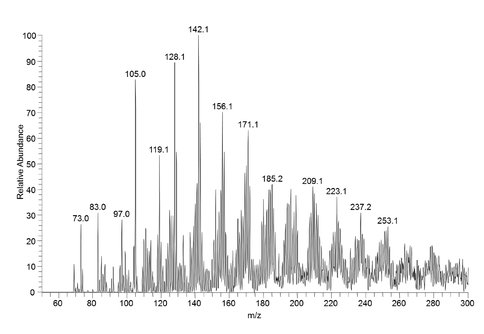2012 Annual Science Report
 NASA Jet Propulsion Laboratory - Titan
Reporting | SEP 2011 – AUG 2012
NASA Jet Propulsion Laboratory - Titan
Reporting | SEP 2011 – AUG 2012
Task 3.4.2 Tholin Analysis Based on Selective Detection of Functional Groups
Project Summary
The goal of this project has been to develop methods to identify and determine the structure of complex organic compounds formed in the Titan environment. These methods also may be useful for in situ chemical analyses in future robotic explorations of Titan’s complex atmospheric and surface chemical environment.
Project Progress
Co-Investigator Jack Beauchamp and Graduate Student Kathleen Upton are developing methods that provide targeted detection of molecules in Titan-like complex organic mixtures that contain specific functional groups, such as nitriles, imines, primary amines, and carbon-carbon multiple bonds. To the extent possible, it is important to develop unbiased sampling methods that can be used to analyze laboratory produced tholins and can be employed as well for in situ chemical analysis carried out in conjunction with future robotic exploration of the Titan chemical environment. To date the majority of the studies of Titan tholins involving mass spectrometry have employed electrospray ionization with a variety of solvents. During the past year, the technique of DART analysis1 (direct analysis in real time) has been applied for tholin analysis and found to work very well with a range of samples.
Working in collaboration with Dr. Farid Salama at NASA Ames Laboratory, samples of organics produced by a rapidly pulsed discharge in a nitrogen/methane mixture have been obtained both by collection on microporous Teflon filters and deposition on mesh grids. Without further sample preparation a miniature DART source built at Caltech has been used to obtain mass spectra employing both sampling methods with a Thermo Scientific LTQ-XL linear quadrupole ion trap mass spectrometer. Figure 1 shows a typical mass spectrum, obtained using the mesh grid, indicating the vast range of molecular species produced in the pulsed discharge tholin source at Ames. Analysis with high resolution mass spectrometry (LTQ-Orbitrap) and MS/MS methodology can provide more detailed structural information. The Teflon filters provide similar results with DART analysis.
In addition to the Titan tholin analysis, circular porous Teflon filters have been employed to analyze complex aerosols produced in Caltech’s smog chamber (in collaboration with Professor John Seinfeld and graduate student Kate Schilling). Aerosols are collected by drawing air from the chamber through the filter. DART-MS analysis works extremely well to detect and determine the structure of complex organic compounds generated, for example, by the photochemical oxidation of n-dodecane. This may someday comprise a viable method for in situ analysis of aerosols in Titan’s atmosphere. In experiments thus far conducted, the DART source has been operated with helium gas. Operation with nitrogen gas is currently being explored.
1. R. B. Cody, J. A. Laramee, and H D. Durst, Versatile New Ion Source for the Analysis of Materials in Open Air under Ambient Conditions, Anal. Chem. 2005, 77, 2297-2302.
 Figure 1. Mass spectrum obtained using DART ionization of Titan simulants formed by the pulsed discharge source at NASA Ames laboratory. The sample is deposited on the center portion of a bow tie shaped mesh wire grid that can be electrically heated by passing a current through the grid to assist sample desorption.
Figure 1. Mass spectrum obtained using DART ionization of Titan simulants formed by the pulsed discharge source at NASA Ames laboratory. The sample is deposited on the center portion of a bow tie shaped mesh wire grid that can be electrically heated by passing a current through the grid to assist sample desorption.
-
PROJECT INVESTIGATORS:
-
PROJECT MEMBERS:
Farid Salama
Collaborator
Kathleen Upton
Doctoral Student
-
RELATED OBJECTIVES:
Objective 2.2
Outer Solar System exploration
Objective 3.1
Sources of prebiotic materials and catalysts
